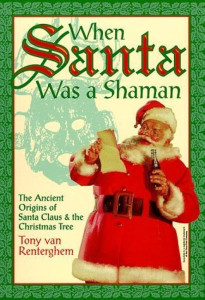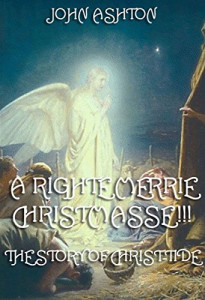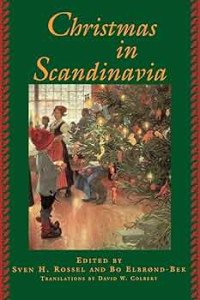 Tony von Renterghem’s When Santa Was a Shaman (Llewellyn Books, 1995)
Tony von Renterghem’s When Santa Was a Shaman (Llewellyn Books, 1995)
Clement Miles’s Christmas Customs and Traditions: Their History and Significance (T. Fisher, Unwin, 1912; Dover, 1976)
John Ashton’s A Righte Merrie Christmasse!!! The Story of Christ-Tide (Benjamin Blom, 1968 – original publication date possibly 1894)
Henry Glassie’s All Silver and No Brass: An Irish Christmas Mumming (Indiana University Press, 1975)
John Chandler’s A Country House Christmas (Sutton Publishing, 1999)
John Hudson’s Dickens’ Christmas (Sutton Publishing, 1999)
Sven Rossel and Bo Elbrond-Bek’s Christmas in Scandinavia (University of Nebraska Press, 1999)
The midwinter celebration, known variously as Christmas, Yule, Saturnalia, Winter Solstice, and so forth, has a very, very long history. No one’s really sure how long ago humans first recognized the winter solstice and began heralding it as a turning point – the day that marks the return of the sun. The coming of the Dark has long been portrayed in myth, story, and festival – just take a look at Susan Cooper’s The Dark is Rising series in which the battle between Light and Dark starts on an otherwise uneventful Midwinter’s Eve. Susan Cooper notes she was “trying to deal with the basic substance of myth: the complicated, ageless conflict between good and evil, the Light and the Dark.” Midwinter’s Eve is a date filled with both myth and tradition.
The books I’ll be looking at range in both their date of printing and subject matter. There are old books, and there are books that are thoroughly modern; there are books about celebrating the holiday in good cheer, and books determined to deconstruct the meaning of it.
First up is When Santa Was a Shaman. Yes, Virginia, there is a Santa Claus. But who is he? Where did he come from? How did a jolly, ruby-cheeked, and very fat man sporting a snow-white beard and dressed in red velvet come to embody the spirit of giving? Tony von Renterghem tells the complex, centuries-old tale of the origin and evolution of the modern Santa Claus. His central thesis is that ancient, pagan shamans are the basis of today’s Santa Claus. He traces their evolution through the Horned God (i.e., Herne), Pan, Wodan, Robin (yes, Robin Hood – see my review of two Robin Hood studies for some observations on the commonalities of both beings), and St. Nicholas.
He also tells the story of how the original Tree of Life – what the Norse call Yggdrasil – became the Christmas tree of today, He traces the history of other present-day traditions, as well. This is definitely a fresh and provocative look at how Christianity, a relative spiritual newcomer in European culture, failed to subjugate the older pagan religions of prehistory. This is a well-thought out look at the folklore, mythology, and traditions surrounding this Winter holiday.
 Christmas Customs and Traditions: Their History and Significance is one of those lovely reprints from Dover Books. Unlike When Santa Was a Shaman, this book is not interested in advancing a thesis as to how Christmas came to be. Instead, it’s a lovely look at Christmas customs and traditions: trees, wreaths, holly, lighting candles, Christmas cards, and feasting.
Christmas Customs and Traditions: Their History and Significance is one of those lovely reprints from Dover Books. Unlike When Santa Was a Shaman, this book is not interested in advancing a thesis as to how Christmas came to be. Instead, it’s a lovely look at Christmas customs and traditions: trees, wreaths, holly, lighting candles, Christmas cards, and feasting.
Did you know that Christmas (as we celebrate it) is a little over a century old, but that Christmas carols date back to the fourth century? While Clement Miles does trace Christmas back to its pagan roots, the focus is on the rites of this festival. The Yule log, the Christmas tree, Christmas food, Christmas in high and popular culture, Christmas dramas, and pre-Christian winter festivals are all covered here. With its insightful writing and well-grounded scholarship, Christmas Customs and Traditions is an important addition to our understanding of this holiday.
John Ashton’s A Righte Merrie Christmasse!!! is a rather odd bugger. It traces Christmas back to a time a thousand years ago. Christmas as we know it is largely a Victorian development. Such traditions as the Christmas tree and Father Christmas are relatively recent in the august course of history. Yet we can recognize, in the Christmas of the late medieval period, the forerunner of our own celebration.
Most of the customs and traditions that the author discusses are from England, but some were common throughout Europe. Until the late Middle Ages, the celebration of Christmas Day ranked fairly low among the major festivals of the Christian world. Twelfth Night celebrations far surpassed the solemn observance of the birth of Jesus Christ, while more festive Yule celebrations were pagan celebrations which, recognized by the Church, persisted into the Christian era.
However, beginning with the rise of the cult of the Virgin Mary in the twelfth century, a trend can be discerned of moving away from the importance of local saints and towards emphasis on the major figures of the Church, especially on the Holy Family. The author notes that it was only then that Christmas became a Church-sanctioned event. The author of this possibly late Victorian tome says in his all-too-brief preface that “It was to view of preserving the memory of Christmas that I have written this book.” In tracing its origins and evolution to the Victorian period, he has helped us to have a clearer understanding of this holiday. [Now available as an ebook from the Gutenberg Project – Ed.]
Mumm me moe mummers! – James Joyce, Finnegan’s Wake
 Being a fiddler in a Celtic band and of Scots-Irish extraction, I’m very intrigued by Celtic aspects of the various midwinter celebrations. Henry Glassie’s All Silver and No Brass: An Irish Christmas Mumming is a superbly-written account of a vanishing Celtic holiday ritual that can be traced back well over three hundred years.
Being a fiddler in a Celtic band and of Scots-Irish extraction, I’m very intrigued by Celtic aspects of the various midwinter celebrations. Henry Glassie’s All Silver and No Brass: An Irish Christmas Mumming is a superbly-written account of a vanishing Celtic holiday ritual that can be traced back well over three hundred years.
RuarÌ Caomhanach, an Irish musician, in an online article on Irish folk drama, says: ” Folk drama is the oldest surviving form of theatrical tradition found in Ireland. The most common forms are Wrenboys, which is the most ancient; Mumming (also sometimes known as Christmas Rhyming, although there can be slight differences between the two), which is the most textually complex; and Strawboys, an interesting variation but, unfortunately, not very widespread these days, although a form of it adapted to modern requirements is relatively common in some parts of County Clare. The rituals of the Wrenboys and the Mummers are similar in many ways – both are performed on specific feast days (particularly December 26th) and are meant to bring good fortune to all concerned, are processional in nature, involve vegetation and animal disguise and blacking of faces, have dramatic content centered on the life-cycle, death and revival, comic crowning, parody, singing and dancing, and, finally but essentially, eating and drinking.”
What Glassie did in studying the Irish Mummers is the neat trick that any ethnographer wishes he or she could do: he gained access without going native, so he could ask questions only an outsider could ask. And ask he did! He asked and received tales about the mummers, their performances, the way mumming used to be in the old days, and the meanings of mumming. Mumming comes to life in a way that will reward both the general reader interested in a fascinating story and any serious student of Celtic folklore.
Meanwhile, John Chandler has compiled a series of readings in A Country House Christmas that will make you nostalgic for an era and time long gone – that of the English country house during the midwinter holidays. Now I was not to the manor born, so I view this collection of writings with the same eye I reserve for robber barons and fat bishops swathed in ermine: can this be real, or is it but a fiction written by someone to entertain her children? The wealth of these folks was so vast that the midwinter holidays became elaborate fantasies held in manors so large they defied rationality. OK, my wife Brigid says enough grumbling…
So how is this book? Quite nice, actually. It draws upon the many surviving descriptions of the feats and revels that took place. My favorite piece is a detailed  accounting of traditional 14th-century feasting as depicted in the romantic poem “Sir Gawain and the Green Knight.” Another highlight is the recounting of the gifts to one person of importance in the early 1600s, to wit: a dove, a half box of oysters, a hog’s head, and two boxes of erigoes. (Hint: the latter kept a couple warm on many a cold winter’s night.) Dances, ghost stories, recipes appropriate to the season, and the weather are all discussed here. Read this collection on a cold winter’s night and it’ll warm the cockles of your heart.
accounting of traditional 14th-century feasting as depicted in the romantic poem “Sir Gawain and the Green Knight.” Another highlight is the recounting of the gifts to one person of importance in the early 1600s, to wit: a dove, a half box of oysters, a hog’s head, and two boxes of erigoes. (Hint: the latter kept a couple warm on many a cold winter’s night.) Dances, ghost stories, recipes appropriate to the season, and the weather are all discussed here. Read this collection on a cold winter’s night and it’ll warm the cockles of your heart.
Dickens’ Christmas will also warm the cockles of your heart – assuming you’re not the pre-enlightened Scrooge. (See my review of Paul Davis’ The Lives and Times of Ebenezer Scrooge for more on that lovable curmudgeon.) Charles Dickens is credited by many for creating the modern Christmas. While that does contain enough truth to stuff the large goose Scrooge bought for the Cratchits on Christmas Day, what Dickens did is far more complex than that.
This book uses well-chosen excerpts from the writings of Dickens and other contemporary writers to illustrate how this seasonal celebration evolved during the 19th century. As the century progressed from the years when Dickens resurrected Christmas among the English to the high Victorian period, Christmas became a family-centered celebration. It was also the time when the more fortunate in English society would remember the needy, though they all told nostalgic tales of years much better than the present day. This collection will give you recollections of winter skating, Christmas at the poor house (a grim affair indeed), feats, gift exchanges, cookery, party games, and other looks at a time not so distant from our own.
Our final book is Sven Rossel and Bo Elbrond-Bek’s Christmas in Scandinavia, a superb anthology of seventeen tales by 19th and 20th century writers from the Scandinavian region and surrounding locations such as the Faroe Islands and Finland. It is from the Nordic region that most of our yule log traditions derive. The dark cold winters of that region inspired the development of traditions concerned with warmth and light. Yuletide, which means “the turning of the sun” or the Midwinters Day, has traditionally been a time of utmost importance in Scandinavia – a time when well-being for the coming year was determined and when the dead were thought to walk the earth. For a long time, it was considered dangerous to sleep alone on Christmas Eve. The extended family, master and servant alike, would sleep together on a fresh pallet of straw. Christmas in Scandinavia homeless wayfaeres seeking solace, excited children awaking on Christmas morn, and a tree that speaks. There is an introduction that speaks of the varied and complex Scandinavian Christmas traditions, the origins and evolution of this holiday with a Scandinavian context, and its celebration today in Scandinavian culture.
That’s enough for now. To quote Ian Anderson, “Hey Santa, pass me that bottle” as this writing has worked up a mighty thirst. Has anyone got a pint of mulled cider I can drink? Merry Christmas to one and all!
